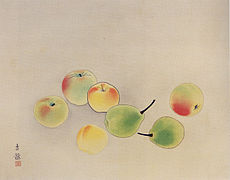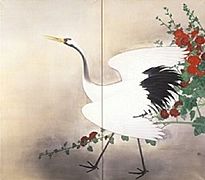Kobayashi Kokei
Kobayashi Kokei ( Japanese 小林 古 径 ; born February 11, 1883 in Takada , today Jōetsu ; † April 3, 1957 ) was a Japanese painter of the Nihonga style.
Live and act
Born Kobayashi Shigeru in Takada, Niigata Prefecture, he began studying Nihonga at an early age. In 1899 he went to Tokyo, and continued his education in the school of Kajita Hanko. In the same year he called himself Kokei and submitted a work for the first time for the exhibition of the private art school Nihon Bijutsuin . In 1907 he became a member of the Tatsumi Gakkai society and exhibited in the Mombushō Bijutsu Tenrankai (abbreviated colorful ). Three years later he became a member of the Kōji-kai, an association of young Nihonga painters. His work "Quelle im Paradies" ( 極 楽 井 , Gokuraku-i ), shown in the sixth colorful exhibition, was awarded a prize. In 1914 he showed his work “Heresy” ( 異端 , Itan ) as part of the revived Inten exhibition and became a member of this association, in which he rose to become one of the central figures.
His early pictures such as “Amida-Halle” ( 阿 弥陀 堂 , Amida-dō , 1915) and “Taketori-Erzählung” ( 竹 取 物語 , Taketori Monogatari , 1917) were romantic with historical references. Later he painted more realistically, as his works “In the bathroom” ( い で ゆ , Ideyu , 1918) and “Mohnblumen” ( ケ シ , Keshi , 1921) show. From 1922 to 1923 he traveled with Maeda Seison through Europe and made a copy of the picture "Admonition of the Court Ladies" by the Chinese artist Gu Kaizhi in the British Museum .
Kokei became a member of the Academy of Arts in 1935 and a professor at the Tōkyō Bijutsu Gakkō in 1944, while also becoming an advisor to the Imperial Court Office . In 1950 he was awarded the Order for Cultural Merit . Other works by him are the pair of adjustable screens “crane and turkey” ( 鶴 と 七 面 鳥 , Tsuru to Shichimenchō , 1928), “Princess Kiyo” (清 姫, Kiyohime , 1930), “hair” ( 髪 , Kami , 1931) and “ Corn ”( ト ウ モ ロ コ シ , Tōmorokoshi , 1939). “Amida Hall” and “Hair” have also appeared as stamps for the Japanese Post .
photos
Remarks
- ↑ Today Tōkyō Geijutsu Daigaku .
literature
- S. Noma (Ed.): Kobayashi Kokei . In: Japan. An Illustrated Encyclopedia. Kodansha, 1993, ISBN 4-06-205938-X , p. 801.
- Tazawa Yutaka: Biographical Dictionary of Japanese Art . Kodansha International, 1981. ISBN 0-87011-488-3 .
Web links
| personal data | |
|---|---|
| SURNAME | Kobayashi, Kokei |
| ALTERNATIVE NAMES | 小林 古 径 (Japanese); 小 林茂 (real name, Japanese); Kobayashi Shigeru (real name) |
| BRIEF DESCRIPTION | Japanese painter |
| DATE OF BIRTH | February 11, 1883 |
| PLACE OF BIRTH | Takada , today Jōetsu |
| DATE OF DEATH | April 3, 1957 |





